


 |
December 7, 2019: A Walking Tour of Buenos Aires |
 |
December 5, 2019: A Boat Tour of the Parana River Delta |
 |
Return to the Index for 2019 |
This is the album page for the second part of our visit to Iguazu Falls. If you wish to return to the page for the first part, you can use the link below:
This page for the second part of our visit to Iguazu Falls will pick up with the Lower Falls Trail.
The Lower Falls Trail
|
This trail would take us through the jungle to a series of stairs down to the Alvar Nunez Falls, and we would cross over the top of them. The trail would then wind around the cliff to offer views of the Brazilian side of the falls and San Martin Island. Years ago, there used to be a bridge to the island, but it was destroyed in a flood about a decade ago. Now, the only way to reach the island is via an excursion boat. These boats also go to the base of the falls, and we debated whether to go down and take a ride. Silvio said that while it is possible to get good pictures from the boat when it gets close to the major falls, you are likely to get wet in the process. Add that caution to the fact that doing the boat ride would probably have meant that we would not have time to visit the Brazilian side of the Falls led us to conclude not to try it.
Instead, we followed the trail along the top of the cliffs, getting good views of the total expanse of the Argentinian falls. We went to the end of that trail for pictures, and then doubled back to stop at Chico Falls and Two Brothers Falls.
This hike would return us to the same point where we started, and we would be well-positioned to walk over to the start point for the Upper Falls Trail.
Nunez Falls
|
|
Before we reached the first set of waterfalls on this trail, the vegetation thinned out and we got some really impressive views looking back up the canyon of the Iguazu towards Devil's Throat.
|
This view up to Devil's Throat was stunning; here are some other views of it:
|
|
These falls, crossed by walkways at the top and midway down the cascade, are the last large cataract in the Iguazu complex. We first came out on the upper walkway, where the pictures below (of the river above, over, and below the falls) were taken:
|
Again, as with almost all waterfalls, you can't really appreciate them unless you see them in person, but maybe a couple of the movies that we took will help:
|
(Mouseover Image Above for Video Controls) |
(Mouseover Image Above for Video Controls) |
We decided not to double back and also walk across the bridge below the falls, but instead continue on the trail back around to the east to see San Martin Island and the incredible views of the widest section of Iguazu Falls. You can see the island and the falls to which we are headed in Fred's panoramic view (taken just after we passed Nunez Falls) of Iguazu Falls:
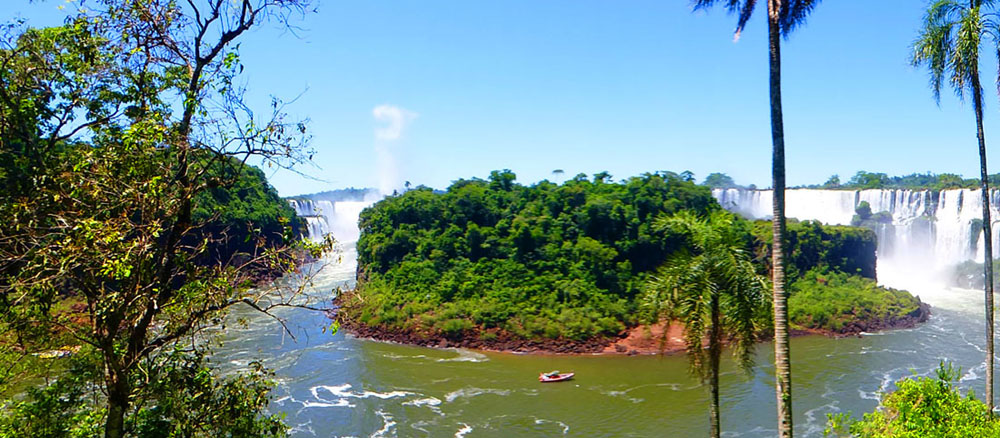 |
The Trail from Nunez Falls to the Base of the Argentinian Falls
 |
We both thought that view was pretty incredible, but there were many more different views as we walked along the walkway above the river. Below us, in the Iguazu River below the falls, we could see some of the tour boats that leave from the dock down below us. Fred got a couple of closeups that you can see here and here.
|
|
Walking along, we saw no coatis, but we did hear and see some monkeys up in the trees. At one point, a beautiful black striped iguana crossed the walkway, but was into the jungle so quickly that the one picture we got just showed a portion of its tail disappearing into the undergrowth. Easier to photograph were some of the butterflies.
|
I was trying to photograph one nearby when another obligingly came and landed right on my hand, folding its wings upward. This allowed Fred to get in close for a good portrait. It stood still for its closeup, and even when Fred moved back it didn't fly away. Actually, even shaking my hand didn't dislodge it, and I had to put my hand close to a railing to get it to step off and onto the metal. It was actually an interesting experience, as the insect seemed totally comfortable with all the people about.
As we got closer and closer to the Argentinian Falls, they of course became more and more impressive. The two views below are quite similar, although the vantage point was a little different for each one. Note the crevasse at the left through which all the water from an entire section of falls is being channeled. The force of the water coming through that constriction must be enormous:
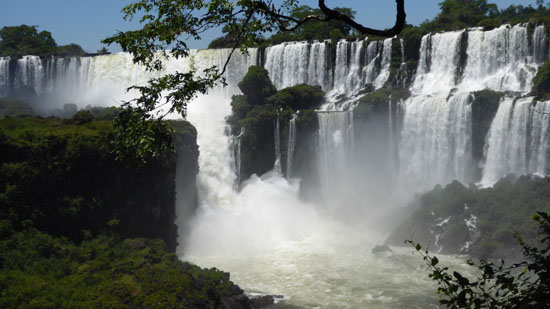 |
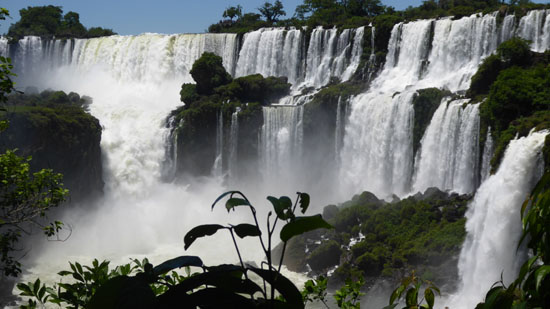 |
If you look at the left-side falls in my panoramic view below, you can see how much water is being forced through that narrow opening. This view is probably the best we have of the Argentinian Falls:
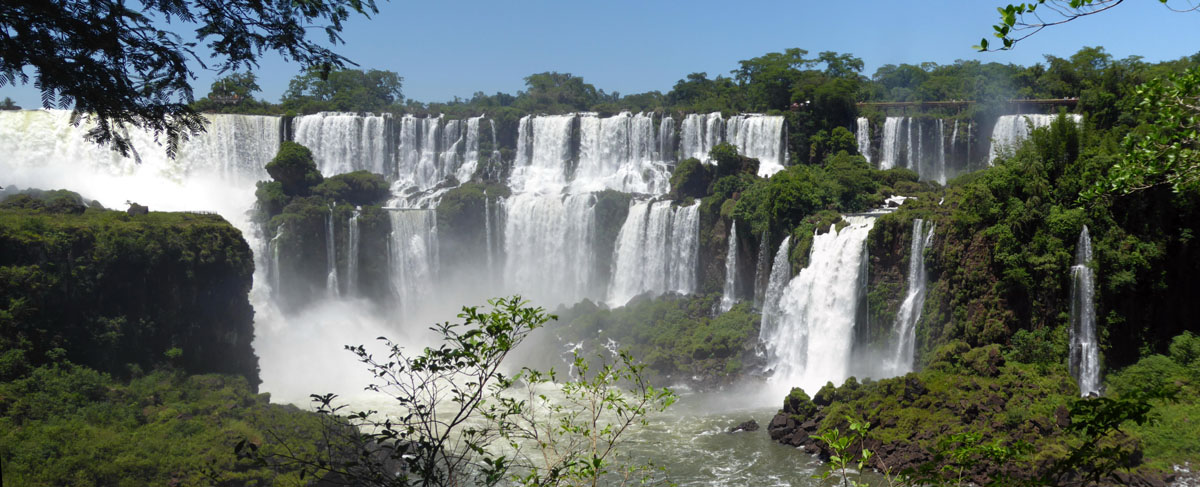 |
We could see ahead of us that the trail would take us right to the base of the falls at the east side of the Argentinian Falls, but I have one more picture and a movie to include in this section.
|
Below is a very good movie that Fred made of one of the tour boats taking its passengers into the spray from the Argentinian Falls. I certainly hope that the boat operators provide raingear!
|
(Mouseover Image Above for Video Controls) |
The trail continued to the base of the Argentinian Falls.
At the Base of Adam, Eve, and Bossetti Falls
|
(Mouseover Image Above for Video Controls) |
|
At right is a small extract of the overall Iguazu Falls Park map showing the east end of the Argentinian Falls. Shortly, you will see pictures of Adam and Eve Falls and Bossetti Falls.
So we continued along the Lower Falls Trail to the point where the trail comes to the viewing platform at the base of Bossetti Falls, which was probably our most "up close and personal" encounter with Iguazu Falls- at least on the Argentinian side.
|
|
(Mouseover Image Above for Video Controls) |
One of his founding changes occurred in 1881, when the newly-federalized province of Corrientes (the federalization of the Misiones province didn't occur until years later) sold 50 leagues of land (almost exactly a quarter-million acres) over the Paraná, Iguazu and Uruguay rivers to private entrepreneurs.
In 1882 a German scientific expedition studied the region in search of land to colonize. One of the explorers was Carlos Bossetti and another, Jordan Hummell, who would organize the first tourist trip to the Iguazu Falls a few years later, but from the Brazilian side, given that the Argentinian side was almost impossible to penetrate.
Here are two excellent views of Bossetti Falls, the first taken from the beginning of the platform area and the second taken from a position so close to the falls that the spray was noticeable:
|
|
Silvio had, of course, been to this spot a zillion times before, so he was pretty blasé about it, standing off to the side or taking a picture when we asked him to. But we were amazed for the second time (the first being at Devil's Throat) to be so close to the falls themselves.
|
|
I hope that the movies and pictures you find on this page might encourage you to visit major waterfalls (if not Iguazu) and experience them for yourself.
Here are a series of pictures taken from the Bossetti Falls platform; I hope they give you an appreciation for the surroundings:
|
To complete our visit to Adam, Eve, and Bossetti Falls, here are two more movies that I took from the base of the falls:
|
(Mouseover Image Above for Video Controls) |
(Mouseover Image Above for Video Controls) |
Chico Falls and Two Sisters Falls
|
As we headed southeast we came to the point where the trail turned off for the walk to Chico Falls. Silvio encouraged us to bypass that trail. Why? There were two reasons. First, he said, he was sure we would find that small waterfall to be small potatoes as up against the other falls we'd seen so far and would see later. Second, he thought that our time would be better spent on the Upper Falls Trail and on our trip later to the Brazilian side of the falls which, he said, we would not want to rush through.
We couldn't argue with his logic; I did want to make sure we had plenty of time to get across the border and into Brazil and then into the Brazilian national park. Silvio said it would take some time to do both, so we continued along the trail to Dos Hermanas.
This pair of lovely waterfalls seemed unlike the rest of Iguazu, because instead of falling over a cliff into a river below, as all the falls so far had done, these falls, separated from the others, fell instead into a picturesque pool (whose outlet was a stream that continued down the slope to become Nunez Falls back down into the Iguazu River. Coming along the trail, we had our first view of Dos Hermanas hidden behind the dense foliage along the trail.
|
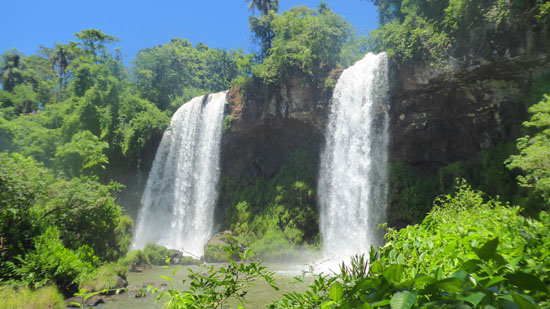 |
On the far side of the bridge was an area from which you could observe the falls without blocking traffic on the bridge, and we spent some time there making movies. That is where we got Silvio to take the picture at left, after none of my four attempts at the perfect selfie here turned out.
As for movies, here are two good ones that we took at Dos Hermanas (although I freely admit that Fred's is better):
|
(Mouseover Image Above for Video Controls) |
(Mouseover Image Above for Video Controls) |
From Dos Hermanas, the last falls on the lower circuit, we simply followed the trail back to the start point. Along the way, there were no more waterfalls, but there was some wildlife:
|
(Mouseover Image Above for Video Controls) |
|
Continuing to the end of the Lower Falls Trail brought us right back to the starting point. Nearby is The Gran Meliá Iguazú hotel- the only one in the park. The hotel opened in 1978 as the Hotel Internacional Iguazú. It replaced the old hotel that had been built in the 1930s and which is now a research building. In 1985 the new hotel served as the base for the three-month filming of the Academy Award-winning film The Mission. In 1998 Starwood Hotels bought the hotel and it became the Sheraton Internacional Iguazú. The hotel was renovated in 2006 and then became part of Meliá Hotels International. Another $20 million renovation was completed in 2018. It has 176 rooms, all with views of the Falls, and four suites with oversize balconies.
Also in this area, between the starting points for the Lower and Upper Falls Trails and quite close to the research building, was this lighthouse-like structure. No one seems to know for sure why it was built in the first place (it has never been an actual lighthouse). Sadly, it hasn't been kept up and when you get close to it, you can see it is in a sad state of repair. Just beyond was the starting point for the Upper Falls Trail.
The Upper Falls Trail
|
This trail would take us through the jungle a short ways to cross the top of the Dos Hermanas Falls, and we would get some nice views from there. The trail would continue over close to the top of Chico Falls (remember we eschewed the trail to their base) and from there through the jungle to an observation platform on the east side of Bossetti Falls. There, we'd be able to look down to the platform at the base of those Falls that we had been to earlier.
Next, the trail would go upstream a bit, cross the small portion of the Iguazu that flows over Bossetti Falls, and then to an observation on the west side of those same falls. So we'd be able to see those falls from both sides.
Next, the trail (actually an elevated metal walkway) moved away from the top of the cliff, passed Adam and Eve Falls, and then came to the last overlook at Mbigua Falls (named for a diving, water fishing bird found in just a small area along the Iguazu between Brazil and Argentina).
From there, we expected (from looking at the park map) to go out to a final platform that overlooks San Martin Falls. This walkway, however, was severely damaged in the last floods four years ago, and has not yet been reopened. So we followed about a mile of this elevated metal walkway, hopping from island to island, working our way back east and south and back to the end of the trail at Cataratas Station.
The Upper Falls Trail: Beginning to Bossetti Falls
|
|
From the platform atop the Dos Hermanas, Fred got a very interesting telephoto shot of the walkway above Bossetti Falls, where we were to find that there were platforms on either side of those falls; this shot showed the platform on the far side. I also got a good selfie picture of the two of us with the Argentinian Falls in the background, and you can see that picture here. We continued along the walkway towards the top of Bossetti Falls, and got some views of Chico Falls (the falls we bypassed earlier) along the way:
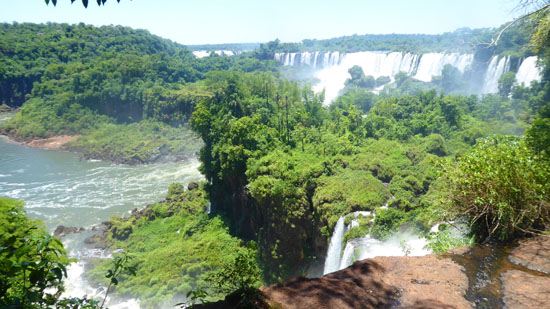 |
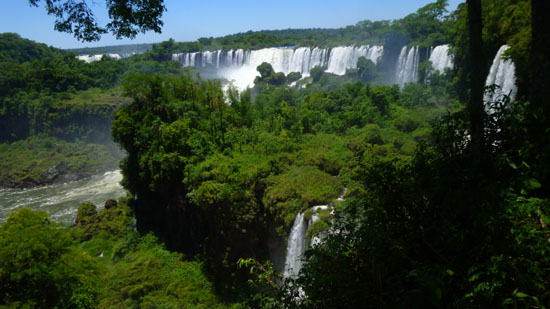 |
And then we reached the platform on the near side (east side) of Bossetti Falls. Here we could see something that wasn't immediately apparent from the base of the falls.
|
(Mouseover Image Above for Video Controls) |
Here are some good pictures that we got from this platform, and in one of them, you can see across the stream that becomes the falls to see our next destination- the platform on the west side of the falls:
|
Next, the trail took us upstream about a hundred feet where a bridge crossed the stream and then the trail went back down towards the cliff and the platform on the west side of Bossetti Falls.
|
|
(Mouseover Image Above for Video Controls) |
At right is a movie that I made while standing on the bridge. In it, I begin by looking upstream, then panning under the bridge, and then looking downstream. In the movie as well, it's not obvious that you are looking out over a waterfall that's easily a couple hundred feet high. If you were in a canoe, you wouldn't know until it was way too late that you were going to be in some serious trouble!
Walking down to the platform right above the cascade, we got some excellent pictures looking across the top of the first cascade of these falls. Fred leaned way out and used his zoom to get an excellent picture of the second (taller) cascade and the viewing platform down below it where we'd been. You should definitely have a look at that picture.
|
|
|
|
The Upper Falls Trail: To the Mbigua Falls Overlook
|
Although there was less water here, we were standing where we could look right down the cliff face if we wanted to, and that lent an extra dimension to the experience. Here are a variety of views taken from this last overlook on the Argentinian side:
|
This was another place where we just paused for a while to let the awesomeness of the scenery and the power of the falls sink in. Silvio was happy to oblige for, as he told us, this is his favorite place on either side of the falls.
|
(Mouseover Image Above for Video Controls) |
Looking upstream from these falls, I noticed something in the distance, so I zoomed in as much as I could. It was part of the trail to Devil's Throat.
Sadly, we couldn't stay here forever, so we took the last few pictures and turned to head on along the metal boardwalk as it first went north and then back east towards the Cataratas Station.
|
|
On the way back to Cataratas Station, I made two movies that are worth including here:
|
(Mouseover Image Above for Video Controls) |
(Mouseover Image Above for Video Controls) |
Walking back from the upper falls took a while; the walkway was over half a mile. I was continually amazed at the work it took to build it, and the work it must take to keep it in usable condition.
|
When we'd arrived five hours ago, the entry plaza for the park was very busy, but now it seemed deserted. I suppose that's because anyone entering now would be hard pressed to see everything before the park closed.
We waited out in front of the entry building for Silvio to go retrieve his car and return to pick us up.
Then it was off to another country- Brazil- to see the falls on the Brazilian side.
If you would like to finish our tour of Iguazu Falls by visiting the Brazilian side of the falls with us, please click on the link below.
If you are finished with your visit to the falls with us, you click on one of the links below to continue to another album page.
 |
December 7, 2019: A Walking Tour of Buenos Aires |
 |
December 5, 2019: A Boat Tour of the Parana River Delta |
 |
Return to the Index for 2019 |